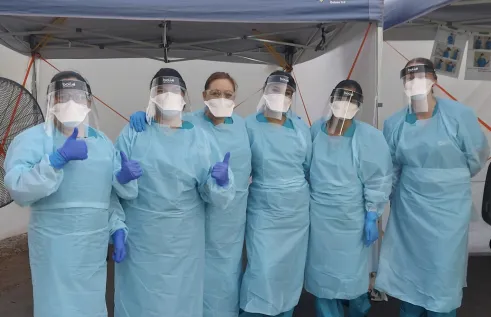Research impact
Are midwives the global key to life-saving preeclampsia care?

After tragically losing a friend to preeclampsia, Dr Isabella Garti is now working to improve the quality of care for those who develop this dangerous pregnancy complication.
Characterised by high blood pressure that usually develops after 20 weeks of pregnancy, preeclampsia affects 5-8% of pregnant women across the globe and is a leading cause of maternal and neonatal deaths.
“What makes preeclampsia dangerous is that it often has no symptoms, so a woman may be unaware she has it,” says Dr Garti.
“By the time it is detected, her blood pressure may already be dangerously high. The sudden increase in her blood pressure could lead to the placenta detaching too early, resulting in preterm birth, stillbirth, or even serious damage to her internal organs. This could include liver damage, kidney damage, and even blindness, among other complications.”
Dr Garti decided to pursue a Higher Degree by Research at Charles Darwin University, where she could find support and inspiration from world-leading midwifery researchers.
The role of midwives
Dr Garti’s research focus on midwifery care is crucial as midwives are often the first point of contact for pregnant woman and provide the majority of care, particularly in low-income and middle-income countries.
This makes the role of the midwife critical in the early detection of preeclampsia and its subsequent management.
“Currently, we lack comprehensive knowledge about how midwives historically cared for women with preeclampsia, their specific contributions, and the resources they require to perform their roles effectively.”
While preeclampsia does not discriminate based on socio-economic background, it heavily influences maternal and foetal outcomes.
This makes Dr Garti’s research particularly relevant for First Nations women who often face higher risks of preeclampsia and related complications due to limited access to healthcare, cultural barrier and socio-economic disparities.
“We can improve early detection by training midwives to spot warning signs like headaches and high blood pressure. Providing better access to necessary medications and tools can help manage the condition more effectively.”
The future impact
“I believe that even one woman lost to preeclampsia is too many.”
This is why Dr Garti wants to see a midwifery future workforce that is fully equipped to manage preeclampsia, and that midwives receive ongoing training in the latest treatment regimens.
“Recent modelling shows that a slight increase in midwife-led interventions has the potential to prevent 22% of maternal deaths, 23% of neonatal deaths, and 14% of stillbirths, potentially saving 1.3 million lives each year by 2035.”
“I hope my findings serve as a launchpad to spark global interest in enhancing midwifery education quality and continuing professional development for midwives.”
CDU is seeking Higher Degree by Research students to take part in research projects just like these. Scholarships are available. Learn more.
Related Articles

How a nursing degree shaped, inspired and challenged Hema
Hema is a proud Nepalese graduate who was determined to make a difference in people’s lives. Committed to advocating for and protecting others, Hema knew a career in nursing was the only path for her.
Read more about How a nursing degree shaped, inspired and challenged Hema
From soccer star to nursing degree: Jessica's story
A knee injury forced A-grade soccer star Jessica to reassess her future. A suggestion from her grandparents led to an online nursing degree at CDU, and now she’s kicking goals in a totally new career.
Read more about From soccer star to nursing degree: Jessica's story
Katie's nursing degree is in the blood
Seeing her mother, grandma and aunt helping people within the local community inspired Darwin local Katie Chesworth to take the leap and study a Bachelor of Nursing at CDU.
Read more about Katie's nursing degree is in the blood